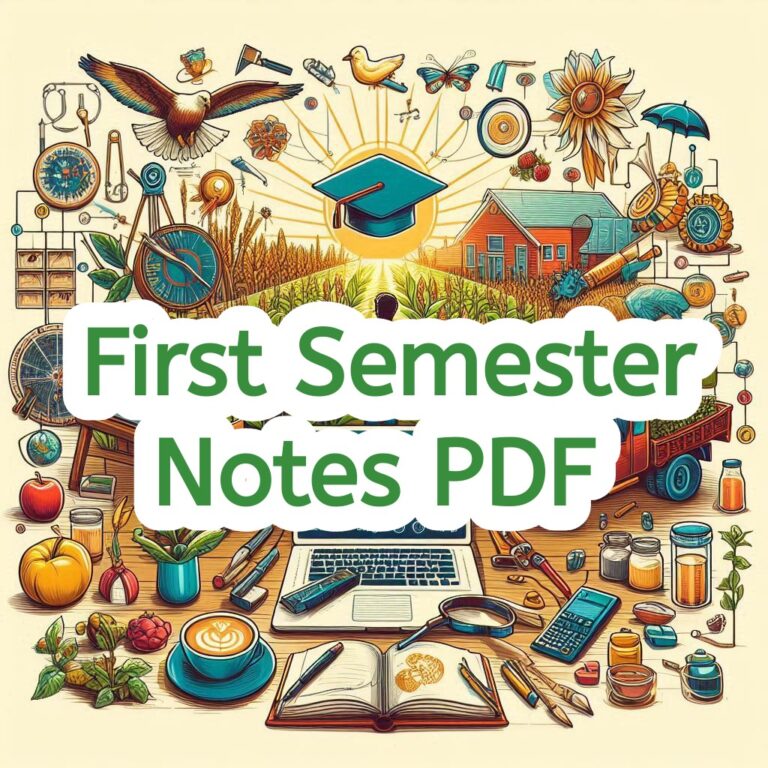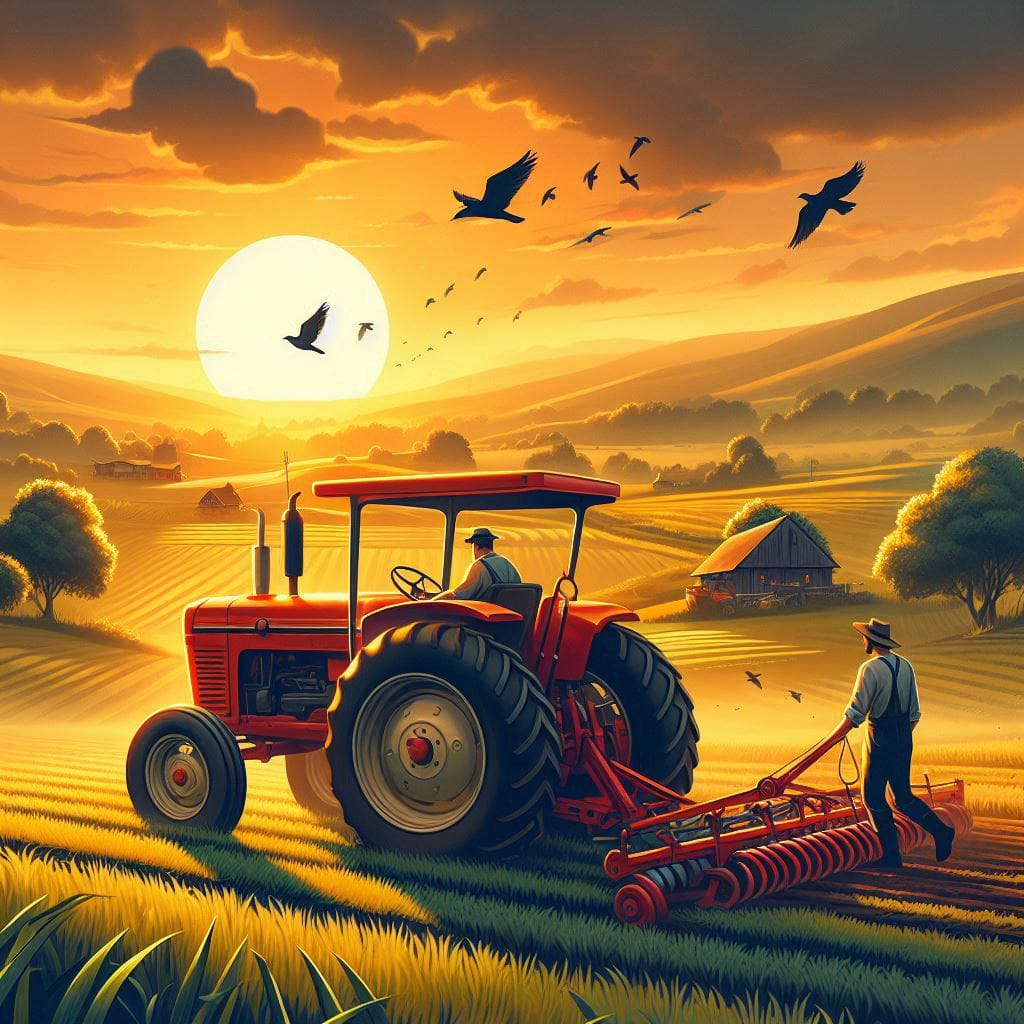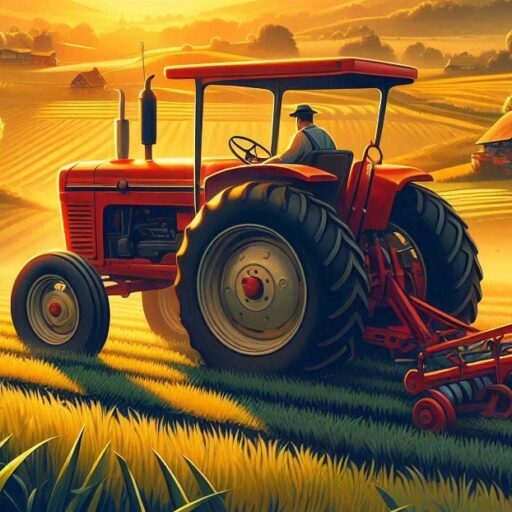BSc Agriculture Notes First Semester – There are total 11 courses in BSc Agriculture first semester. All of the notes are given below click on the link to download the notes pdf.
About BSc Agriculture
BSc Agriculture is an undergraduate four years program divided into eight semesters focused on the science and practice of farming and crop production. It covers a range of topics including soil science, plant biology, pest management, and agricultural economics. This degree prepares students for careers in farming, agribusiness, research, and environmental management, combining theoretical knowledge with practical skills to address global food security and sustainable agricultural practices.
BSc Agriculture Notes First Semester Notes pdf
| Courses | ICAR Notes |
| Fundamentals of Agronomy | Download |
| Fundamentals of Horticulture | Download |
| Fundamentals of Soil Science | Download |
| Fundamentals of Plant Biochemistry and Biotechnology | Download |
| Comprehension & Communication Skills in English | Download |
| Introductory Biology | Download |
| Elementary Mathematics | Download |
| Agriculture Heritage | Download |
| Rural Sociology & Educational Psychology | Download |
| Human Values & Ethics | Download |
| NSS/NCC/Physical Education & Yoga Practices** | Download |
BSc Agriculture Second Semester Notes Download
BSc Agriculture 3rd semester Notes Download
BSc Agriculture 4th semester Notes Download
BSc Agriculture 5th semester Notes Download
BSc Agriculture 6th semester Notes Download
BSc Agriculture 1st Semester Notes Download
BSc Agriculture Notes First Semester Syllabus
Fundamentals of Horticulture 2(1+1)
Theory
Horticulture-Its definition and branches, importance and scope; horticultural and botanical classification; climate and soil for horticultural crops; Plant propagation-methods and
propagating structures; principles of orchard establishment; Principles and methods of training and pruning, juvenility and flower bud differentiation; unfruitfulness; pollination,
pollinizers and pollinators; fertilization and parthenocarpy; kitchen gardening; garden types and parts; lawn making; medicinal and aromatic plants; species and condiments; use
of plant bio-regulators in horticulture. Irrigation & fertilizers application-method and quantity.
Practical
Identification of garden tools. Identification of horticultural crops. Preparation of seed bed/nursery bed. Practice of sexual and asexual methods of propagation. Layout and
planting of orchard plants. Training and pruning of fruit trees. Transplanting and care of vegetable seedlings. Making of herbaceous and shrubbery borders. Preparation of
potting mixture, potting and repotting. Fertilizer application in different crops. Visits to commercial nurseries/orchard.
Fundamentals of Plant Biochemistry and Biotechnology3(2+1)
Theory
Importance of Biochemistry. Properties of Water, pH and Buffer. Carbohydrate: Importance and classification. Structures of Monosaccharides, Reducing and oxidizing properties of Monosaccharides, Mutarotation; Structure of Disaccharides and Polysaccharides. Lipid: Importance and classification; Structures and properties of fatty acids; storage lipids and membrane lipids. Proteins: Importance of proteins and classification; Structures, titration and zwitterions nature of amino acids; Structural organization of proteins.
Enzymes: General properties; Classification; Mechanism of action; Michaelis & Menten and Line Weaver Burk equation & plots; Introduction to allosteric enzymes.
Nucleic acids: Importance and classification; Structure of Nucleotides, A, B & Z DNA; RNA: Types and Secondary & Tertiary structure. Metabolism of carbohydrates: Glycolysis, TCA cycle, Glyoxylate cycle, Electron transport chain. Metabolism of lipids: Beta oxidation, Biosynthesis of fatty acids.
Concepts and applications of plant biotechnology: Scope, organ culture, embryo culture, cell suspension culture, callus culture, anther culture, pollen culture and ovule culture and their applications; Micro-propagation methods; organogenesis and embryogenesis, Synthetic seeds and their significance; Embryo rescue and its significance; somatic hybridization and cybrids; Somaclonal variation and its use in crop improvement; cryo-preservation; Introduction to recombinant DNA methods: physical (Gene gun method), chemical (PEG mediated) and Agrobacterium mediated gene transfer methods; Transgenics and its importance in crop improvement; PCR techniques and its applications; RFLP, RAPD, SSR; Marker Assisted Breeding in crop improvement; Biotechnology regulations.
Practical
Preparation of solution, pH & buffers, Qualitative tests of carbohydrates and amino acids. Quantitative estimation of glucose/ proteins. Titration methods for estimation of amino acids/lipids, Effect of pH, temperature and substrate concentration on enzyme action, Paper chromatography/ TLC demonstration for separation of amino acids/ Monosaccharides. Sterilization techniques. Composition of various tissue culture media and preparation of stock solutions for MS nutrient medium. Callus induction from various explants. Micro-propagation, hardening and acclimatization. Demonstration on isolation of DNA. Demonstration of gel electrophoresis techniques and DNA finger printing.
Fundamentals of Soil Science 3(2+1)
Theory
Soil as a natural body, Pedological and edaphological concepts of soil; Soil genesis: soil forming rocks and minerals; weathering, processes and factors of soil formation; Soil Profile, components of soil; Soil physical properties: soil-texture, structure, density and porosity, soil colour, consistence and plasticity; Elementary knowledge of soil taxonomy
classification and soils of India; Soil water retention, movement and availability; soil air, composition, gaseous exchange, problem and plant growth; source, amount and flow of
heat in soil; soil temperature and plant growth; Soil reaction-pH, soil acidity and alkalinity, buffering, effect of pH on nutrient availability; soil colloids – inorganic and organic;
silicate clays: constitution and properties; sources of charge ion exchange, cation exchange capacity, base saturation; soil organic matter: composition, properties and its influence on soil properties; humic substances – nature and properties; soil organisms: macro and micro organisms, their beneficial and harmful effects;
Soil pollution – behaviour of pesticides and inorganic contaminants, prevention and mitigation of soil pollution.
Practical
Study of soil profile in field. Study of soil sampling tools, collection of representative soil sample, its processing and storage. Study of soil forming rocks and minerals.
Determination of soil density, moisture content and porosity. Determination of soil texture by feel and Bouyoucos Methods. Studies of capillary rise phenomenon of water in soil
column and water movement in soil. Determination of soil pH and electrical conductivity. Determination of cation exchange capacity of soil. Study of soil map. Determination of
soil colour. Demonstration of heat transfer in soil. Estimation of organic matter content of soil.
Introduction to Forestry 2(1+1)
Theory
Introduction – definitions of basic terms related to forestry, objectives of silviculture, forest classification, salient features of Indian Forest Policies. Forest regeneration, Natural
regeneration – natural regeneration from seed and vegetative parts, coppicing, pollarding, root suckers; Artificial regeneration – objectives, choice between natural and artificial
regeneration, essential preliminary considerations. Crown classification. Tending operations – weeding, cleaning, thinning – mechanical, ordinary, crown and advance thinning.
Forest mensuration – objectives, diameter measurement, instruments used in diameter measurement; Non instrumental methods of height measurement – shadow and single
pole method; Instrumental methods of height measurement – geometric and trigonometric principles, instruments used in height measurement; tree stem form, form factor,
form quotient, measurement of volume of felled and standing trees, age determination of trees. Agroforestry – definitions, importance, criteria of selection of trees in agroforestry, different agroforestry systems prevalent in the country, shifting cultivation, taungya, alley cropping, wind breaks and shelter belts, home gardens. Cultivation practices of two important fast growing tree species of the region.
Practical
Identification of tree-species. Diameter measurements using calipers and tape, diameter measurements of forked, buttressed, fluted and leaning trees. Height measurement of
standing trees by shadow method, single pole method and hypsometer. Volume measurement of logs using various formulae. Nursery lay out, seed sowing, vegetative
propagation techniques. Forest plantations and their management. Visits of nearby forest based industries.
Comprehension and Communication Skills in English 2(1+1)
Theory
War Minus Shooting- The sporting Spirit. A Dilemma- A layman looks at science Raymond B. Fosdick. You and Your English – Spoken English and broken English G.B. Shaw.
Reading Comprehension, Vocabulary- Antonym, Synonym, Homophones, Homonyms, often confused words. Exercises to Help the students in the enrichment of vocabulary
based on TOEFL and other competitive examinations. Functional grammar: Articles, Prepositions, Verb, Subject verb Agreement, Transformation, Synthesis, Direct and Indirect
Narration. Written Skills: Paragraph writing, Precise writing, Report writing and Proposal writing. The Style: Importance of professional writing. Preparation of Curriculum Vitae
and Job applications. Synopsis Writing. Interviews: kinds, Importance and process.
Practical
Listening Comprehension: Listening to short talks lectures, speeches (scientific, commercial and general in nature). Oral Communication: Phonetics, stress and intonation,
Conversation practice. Conversation: rate of speech, clarity of voice, speaking and Listening, politeness & Reading skills: reading dialogues, rapid reading, intensive reading,
improving reading skills. Mock Interviews: testing initiative, team spirit, leadership, intellectual ability. Group Discussions.
Fundamentals of Agronomy 4(3+1)
Agronomy and its scope, seeds and sowing, tillage and tilth, crop density and geometry, Crop nutrition, manures and fertilizers, nutrient use efficiency, water resources,
soil plant water relationship, crop water requirement, water use efficiency, irrigation- scheduling criteria and methods, quality of irrigation water, water logging.
Weeds- importance, classification, crop weed competition, concepts of weed management-principles and methods, herbicides- classification, selectivity and resistance,
allelopathy. Growth and development of crops, factors affecting growth and development, plant ideotypes, crop rotation and its principles, adaptation and distribution of crops,
crop management technologies in problematic areas, harvesting and threshing of crops.
Practical
Identification of crops, seeds, fertilizers, pesticides and tillage implements, Effect of sowing depth on germination and seedling vigour, Identification of weeds in crops,
Methods of herbicide and fertilizer application, Study of yield contributing characters and yield estimation, Seed germination and viability test, Numerical exercises on fertilizer
requirement, plant population, herbicides and water requirement, Use of tillage implements-reversible plough, one way plough, harrow, leveler, seed drill, Study of soil moisture measuring devices, Measurement of field capacity, bulk density and infiltration rate, Measurement of irrigation water.
Introductory Biology 2(1+1)
Theory
Introduction to the living world, diversity and characteristics of life, origin of life, Evolution and Eugenics. Binomial nomenclature and classification Cell and cell division.
Morphology of flowing plants. Seed and seed germination. Plant systematic- viz; Br assicaceae, Fabaceae and Poaceae. Role of animals in agriculture.
Practical
Morphology of flowering plants – root, stem and leaf and their modifications. Inflorence, flower and fruits. Cell, tissues & cell division. Internal structure of root, stem and leaf.
Study of specimens and slides. Description of plants – Brassicaceae, Fabaceae and Poaceae.
Elementary Mathematics 2(2+0)Theory
Straight lines : Distance formula, section formula (internal and external division), Change of axes (only origin changed), Equation of co-ordinate axes, Equation of lines parallel to
axes, Slope-intercept form of equation of line, Slope-point form of equation of line, Two point form of equation of line, Intercept form of equation of line, Normal form of equation
of line, General form of equation of line, Point of intersection of two st. lines, Angles between two st. lines, Parallel lines, Perpendicular lines, Angle of bisectors between two
lines, Area of triangle and quadrilateral.Circle: Equation of circle whose centre and radius is known, General equation of a circle, Equation of circle passing through three given
points, Equation of circle whose diameters is line joining two points (x1, y1) & (x2,y2), Tangent and Normal to a given circle at given point (Simple problems), Condition of tangency
of a line y = mx + c to the given circle x2 + y2 = a2.Differential Calculus : Definition of function, limit and continuity, Simple problems on limit, Simple problems on continuity, Differentiation of xn , ex , sin x & cos x from first principle, Derivatives of sum, difference, product and quotient of two functions, Differentiation of functions of functions (Simple problem based on it),
Logarithmic differentiation (Simple problem based on it), Differentiation by substitution method and simple problems based on it, Differentiation of Inverse
Trigonometric functions. Maxima and Minima of the functions of the form y=f (x) (Simple pr oblems based on it).
Integral Calculus : Integration of simple functions, Integration of Product of two functions, Integration by substitution method, Definite Integral (simple problems based on it),
Area under simple well-known curves (simple problems based on it).
Matrices and Determinants: Definition of Matrices, Addition, Subtraction, Multiplication, Transpose and Inverse up to 3rd order, Properties of determinants up to 3rd order and
their evaluation.
Agriculture Heritage 1(1+0)
Theory
Introduction of Indian agricultural heritage, status of farmers in society; advice by sages to kings on their duties towards farmers, soil management in ancient, medieval & pre- modern India and its relevance in modern day sustainable agriculture, heritage of crop & water management, plant growth and development & plant protection through
vrikshayurveda and traditional knowledge. Heritage of medicinal plants and their relevance today, seed health in ancient & medieval history and its relevance to present day
agriculture, description of Indian civilization and agriculture by travelers from China, Europe and United States, our journey in agriculture, green revolution and its impact and
concerns, vision for the future.
Rural Sociology & Educational Psychology 2(2+0)
Theory
Sociology and Rural sociology: Definition and scope, its significance in agriculture extension, Rural society, Social Groups, Social Stratification, Culture concept, Social Institution,
Social Change & Development. Educational psychology: Meaning & its importance in agriculture extension. Behaviour : Cognitive, affective, psychomotor domain, Personality,
Learning, Motivation, Theories of Motivation, Intelligence.



